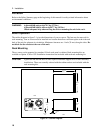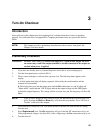
Installation - 2
21
OVP Considerations
The overvoltage protection circuit senses voltage near the output terminals, not at the load. Therefore the
signal sensed by the OVP circuit can be significantly higher than the actual voltage at the load. When
using remote sensing, you must program the OVP trip voltage high enough to compensate for the voltage
drop between the output terminals and the load.
Output Rating
In remote sense applications, the voltage drop in the load leads subtracts from the available load voltage
(see "Remote Sensing Capability" in appendix A). As the ac source increases its output to overcome this
voltage drop, the sum of the programmed voltage and the load-lead drop may exceed the ac source’s
maximum voltage rating. This will not damage the unit, but may trip the OV protection circuit, which
senses the voltage at the output terminals.
Trigger Connections
The BNC trigger connectors on the rear panel let you apply trigger signals to the ac source as well as
generate trigger signals from the ac source. The electrical characteristics of the trigger connectors are
described in appendix A. More information on programming external triggers is found in Chapter 4 of
the ac source Programming Guide.
Trigger IN Allows negative-going external trigger signals to trigger the ac source.
Trigger OUT Generates a negative-going pulse when the selected transient output has occurred.
Digital Connections
This connector, which is on the rear panel, is for connecting the fault and the inhibit signals. The fault
(FLT) signal is also referred to as the DFI signal in the front panel and SCPI commands. The inhibit
(INH) signal is also referred to as the RI signal in the front panel and SCPI commands.
The connector accepts wires sizes from AWG 22 to AWG 12. Disconnect the mating plug to make your
wire connections. The electrical characteristics of the digital connectors are described in appendix A.
More information on programming the digital connectors is found in Chapter 4 of the ac source
Programming Guide.
NOTE: It is good engineering practice to twist and shield all signal wires to and from the digital
connectors
The following examples show how you can connect the FLT/INH circuits of the ac source.
In example A, the INH input connects to a switch that shorts pin + to pin ⊥ whenever it is necessary to
disable output of the unit. This activates the remote inhibit (RI) circuit, which turns off the ac output. The
front panel Prot annunciator comes on and the RI bit is set in the Questionable Status Event register. To
re-enable the unit, first open the connection between pins + and ⊥ and then clear the protection circuit.
This can be done either from the front panel or over the GPIB /RS-232.


















